Hyacinth is a sweetly fragrant flower originated in the Mediterranean, Middle East, and Asia Minor. According to an ancient Greek legend, the name of this plant comes from the blood of young Hyakinthos. After the god Zephyr killed this handsome boy, Apollo named this lovely flower after him.
A German doctor Leonhardt Rauwolf brought Hyacinths in Western Europe from Turkey in 1573. Since then, many gardeners from the United Kingdom and the Netherlands have cultivated this beautiful flower commercially.
Toxicity of Hyacinth Flower
Be careful when planting Hyacinths in your garden because this plant contains oxalic acid, and it is toxic after consuming. Therefore, keep your children, horses, cats, and dogs far away from bulbs.
Some gardeners may experience itching and skin irritation when handling the bulbs. Therefore, you should wear garden gloves when digging them from the ground.
Varieties of Hyacinth Flower
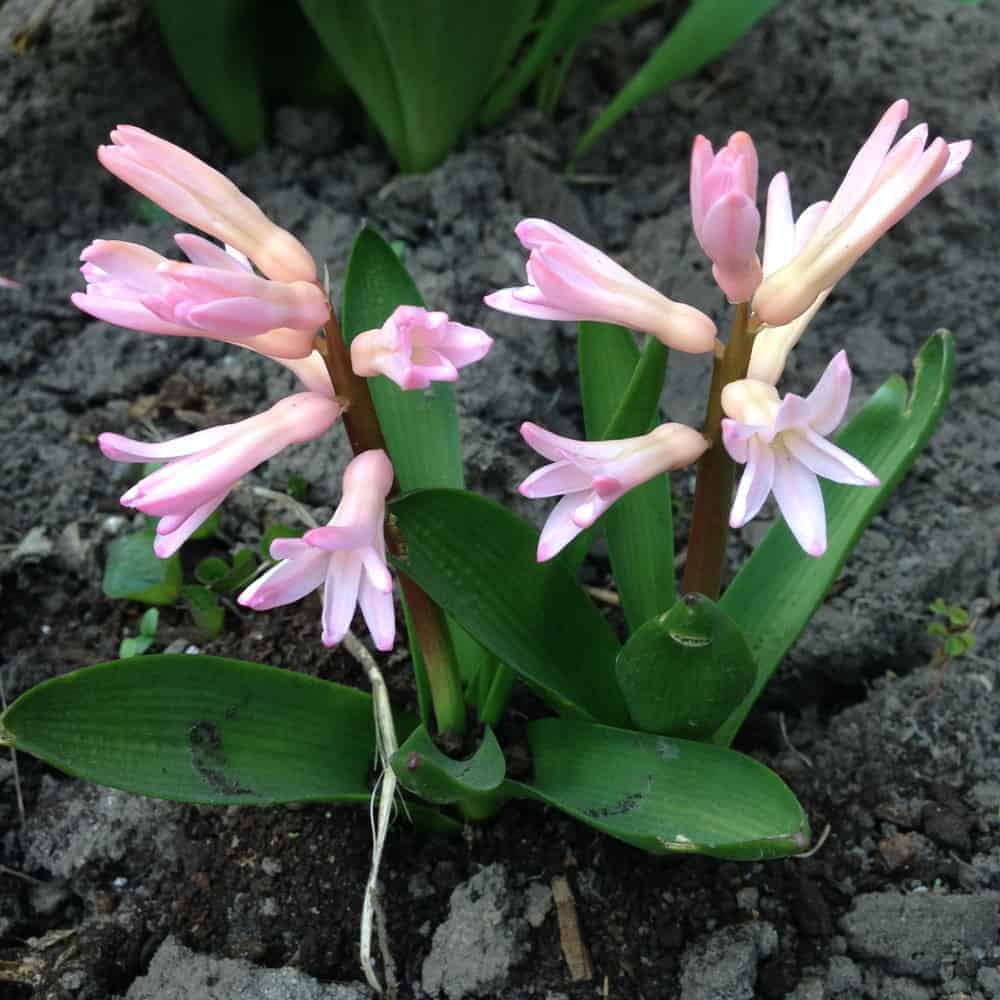
For more than 400 years, this genus included about thirty species and 500 varieties. However, most of the species were arranged to another genus after the new reorganization.
Nowadays, just three species left in this group, including Hyacinthus orientalis (garden hyacinth), Hyacinthus transcaspicus, and Hyacinthus litwinowii. They are classified by:
- The color of flowers (white, blue, red, lilac, pink, yellow/orange)
- The blooms shape (simple and double)
- The period of blooming (early, middle and late)
The primary classification of Hyacinths is by color.
Varieties of Hyacinth |
||||
|
Variety |
Color | Period of blooming | How long it blooms |
Height |
White variety |
||||
|
Arentine Arendsen |
White or cream | Early variety | 15 to 18 days | 8 to 8.5 inches
(20 – 21.5 cm) |
| Madame Sophie | Double white | Mid-variety | 13 to 15 days |
7.5 to 9 inches (19 – 23 cm) |
|
Snow Crystal |
Double white | Late variety | 13 to 18 days |
10 to 11 inches (25 – 28 cm) |
Blue variety |
||||
|
Marie |
Dark-blue with a violet strip | Early variety | 16 to 18 days | 10 to 14 inches
(25 – 35.5 cm) |
| Queen of the Blues | Light-blue | Mid-variety | 14 days |
12 inches (30.5 cm) |
|
Perle Brillante |
Pale-blue | Late variety | 21 days |
10 inches (25 cm) |
Red variety |
||||
|
La Victoire |
Red and pink | Early variety | 11 to 12 days | 8 to 11 inches
(20 – 28 cm) |
| Tubcrgen’s Scarlet | Bright-red | Mid-variety | 15 days |
8 to 8.5 inches (20 – 21.5 cm) |
|
Hollyhock |
Double crimson-red | Late variety | 15 to 18 days |
8 to 8.5 inches (20 – 21.5 cm) |
Lilac variety |
||||
|
Bismarck |
Pale-purple with a light strip | Early variety | 14 days | 9 to 10 inches
(23 – 25 cm) |
| Blue Magic | Purple-violet | Mid-variety | 10 to 12 days |
10 inches (25 cm) |
|
Indigo King |
Black-violet | Late variety | 14 days |
6 to 7 inches (15 – 18 cm) |
Pink variety |
||||
|
Moreno |
Pink-raspberry with a dark stripe | Early variety | 13 to 18 days | 8 to 9 inches
(20 – 23 cm) |
| Anna Marie | Light-pink | Mid-variety | 15 to 17 days |
8 to 10 inches (20 – 25 cm) |
|
Gertruda |
Dark-pink | Late variety | 13 to 15 days |
9 to 10 inches (23 – 25 cm) |
Yellow and orange varieties |
||||
|
Oranje Boven |
Salmon-apricot with dark-pink edges | Mid-variety | 14 days | 8.5 to 9.5 inches
(21.5 – 24 cm) |
| Yellow Hammer | Bright-yellow | Mid-variety | 13 to 15 days |
9 to 10 inches (23 – 25 cm) |
|
City of Haarlem |
Light-yellow | Late variety | 15 to 17 days |
10 to 11 inches (25 – 28 cm) |
No one knows why, but blue varieties usually bloom first. After them, you will see white, pink, red, and lilac flowers. Yellow and orange ones will flourish much later.
You can take advantage of that feature and plant different varieties in your garden. That way, you will get a long blooming period of these impressive plants.
How to Plant Hyacinth Flower in Your Garden
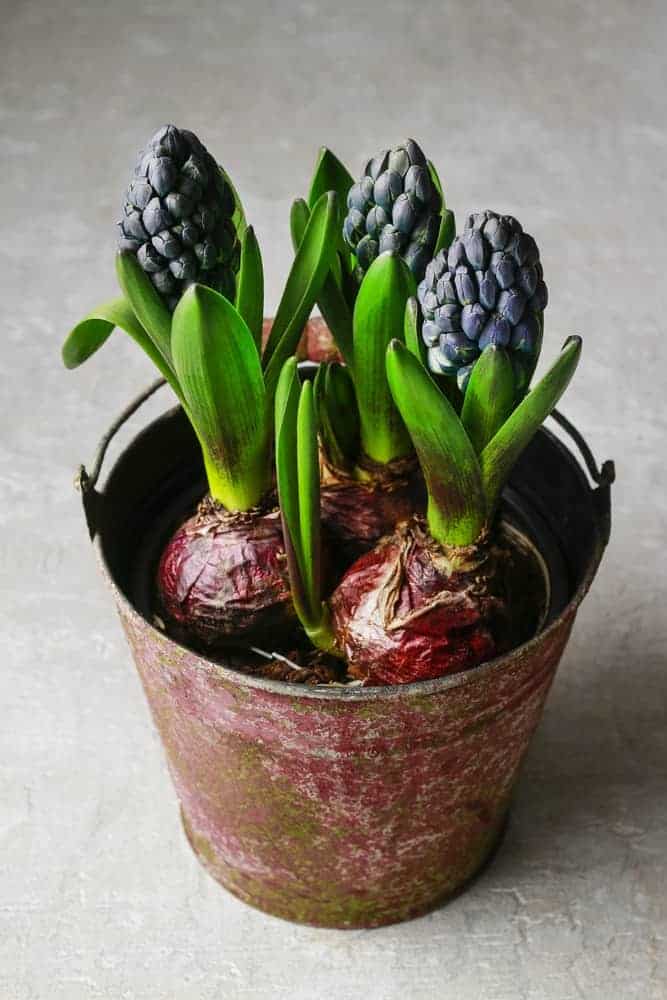
Propagation by seeds
Propagating Hyacinth by seeds is a quite easy process, but the fact is that they are often sterile. If you decide to try this way, you should start by removing seeds from blooms after fading.
Fill a pot with a starting mix and spread prepared seeds evenly on the soil surface. Cover them with coarse sand and water regularly.
Keep the pot in a cool place until seeds ripen during a year. After that period, you can transplant seedlings into your garden. Unfortunately, you need to wait for two to three years to see the first flowers.
Propagation with bulbs
You will notice that young bulbs appear at the base of the main bulb of your plant, and you can always use them to propagate the new plants. Plus, some gardeners use these bulbs to develop new cultivars.
Begin by making a few cuts through the mother bulb. After approximately three months, you will see new bulbs developing around the cuts. You can use them to propagate new plants.
Start by re-planting the parent bulb with the new bulblets about 1 inch (2.5 cm) deep into a pot. Cover them with a layer of compost and let the offset bulbs mature for several weeks.
You can expect a decay of a mother bulb over time, while young ones sprout and grow. During the first year, your tiny bulblets will produce new leaves. It is a moment to separate them from the mother bulb and plant them into the garden.
Place young bulbs to a depth, which is two to three times their diameter, and arrange them 3 inches (7.6 cm) apart. It is essential to avoid any contact between them. Expect new blooms after three to five years.
How to Care Hyacinth Flower in Your Garden
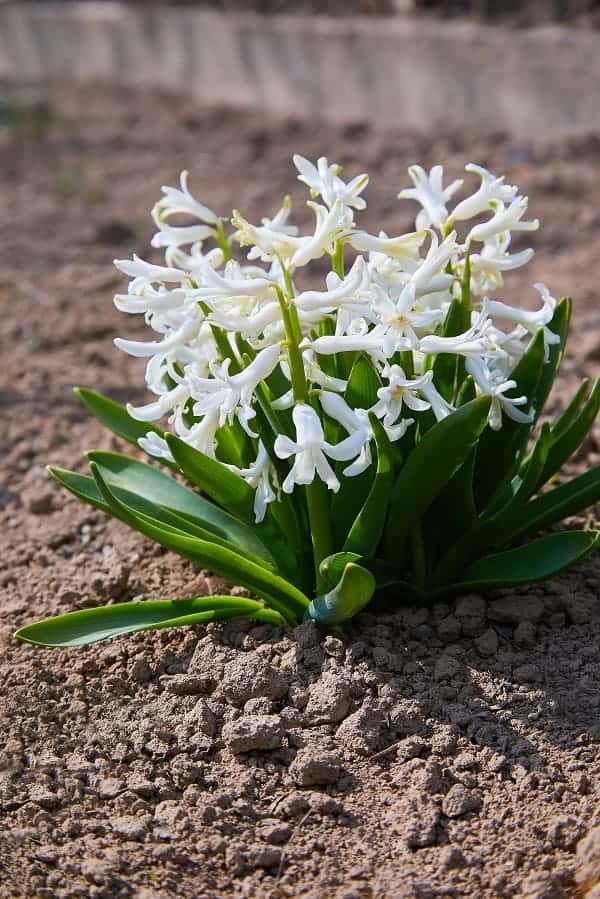
Soil
Plant this lovely flower in the well-draining ground to avoid bulb rot. Don’t expect this plant to tolerate the soggy and too fertile soil, which may cause the occurrence of floppy stems.
The ground should be moderately fertile, neutral to slightly acidic, and consisting of turf dirt, leaf, and baking powder. If it is too acid, you can solve the problem by applying lime. On the other hand, if the soil in your garden is predominantly clay, you should mix it with sand before planting.
Regular loosening of the soil with a high-quality garden shovel is crucial. It will prevent drying the ground and help you with weed control. Every time after this activity, you need to add a layer of mulch to protect your Hyacinth.
Light
Always plant your flower in full sun, but provide partial shade for it during the afternoons. Even though this plant needs bright lighting, it actually doesn’t like direct sunlight.
Temperatures
Hyacinth will need protection throughout winter if you live in one of the northern states. Even in the case that you do everything right, the bulbs won’t live longer than four years.
On the other hand, you will need to dig up the bulbs every autumn if you live in the southern state. The reason is that they require coldness during the dormancy period to bloom abundantly in spring.
That means that you need to store bulbs in a refrigerator if the ground in your garden doesn’t chill enough. You should do that just if the temperatures in winter don’t go lower than 60 F (15.5 C) on average.
Watering
The essential thing is watering bulbs in autumn, right away after planting. Take care to keep the ground moderately moist throughout the fall and early winter. However, avoid too much watering unless it has rained for a longer period. That way, you will protect your bulbs from rotting.
Also, Hyacinth requires a little water during blooming and doesn’t need it at all in a period of dormancy. Begin watering again as soon as you notice the new growth in spring.
If you plant your plant in a bed, you should provide approximately 1 inch (2.5 cm) of water a week, especially when days are dry and hot. If you have the irrigation system in the garden, try to keep the ground wet about 6 to 8 inches (15 – 20 cm) deep in summer.
Fertilizing
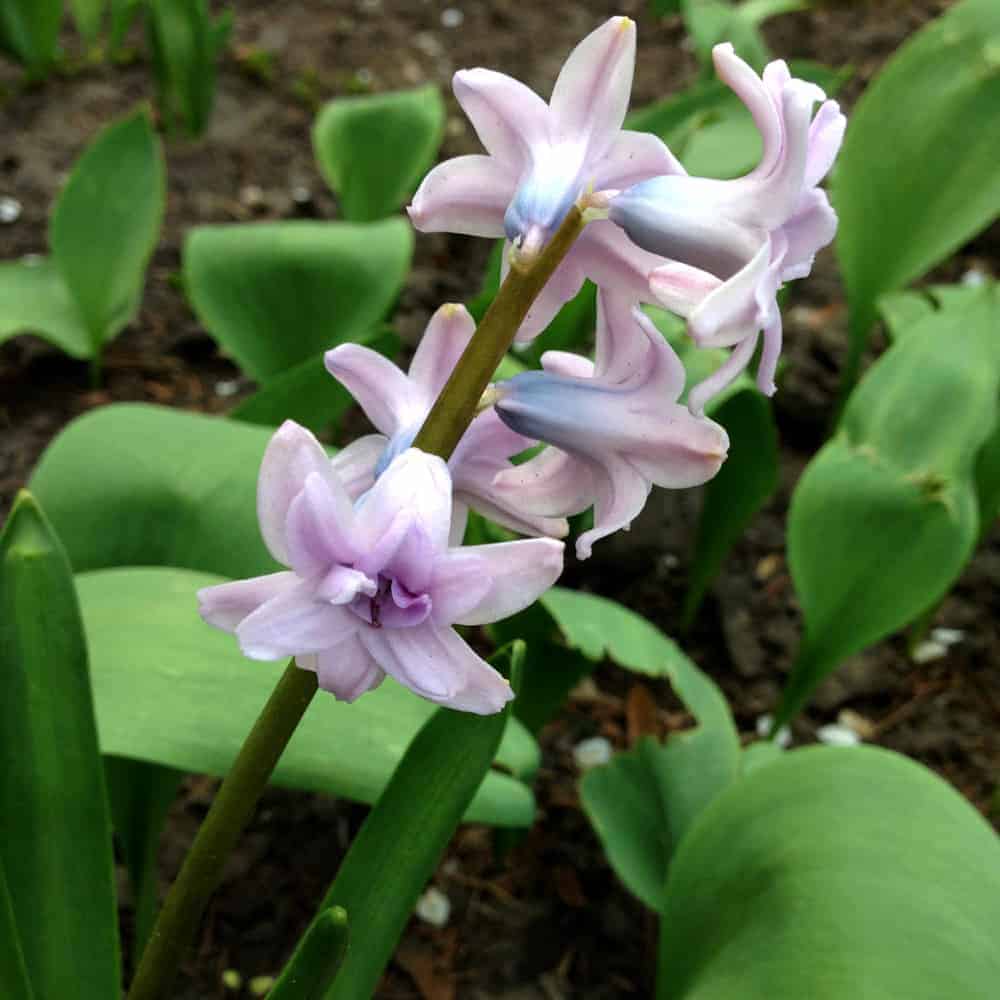
When planting your flower, it is necessary to add bone meal or granular fertilizer formulated for bulbs to feed them adequately. After that, the best option is to apply a layer of compost every year to provide enough nutrients for bulbs. Do it in spring when young plants appear.
Some gardeners fertilize Hyacinth in autumn to encourage the healthy growth of roots. However, never feed this plant right away after flourishing. In that period, bulbs can’t use nutrients appropriately, and you can risk causing the occurrence of various diseases.
Mulching
To protect your plant from weeds and keep the soil moist, you should add a 1 or 2 inches (2.5 – 5 cm) thick layer of mulch around your lovely Hyacinth. The best options are shredded bark, chopped leaves, and wood chips.
Weeding
Hyacinth requires cleanness for healthy growth, so you need to keep weeds under control. Regularly weed the site where your flower grows, and enjoy impressive blooming in spring.
Protecting
Your Hyacinth will suffer if you leave it unprotected, especially if you live in the windy region. Solve the problem by planting smaller varieties or placing them near a tree or shrub.
Supporting
If you pick out taller variety, you can expect stems to flop over after severe winds or heavy rains. Therefore, you should stake them. The other solution is to plant more flowers together so that they will support one another.
Deadheading
Don’t miss to cut off wilted blooms to help your plant to store energy in the bulbs for the next season. The other option is to break a stalk to prevent flowers go to seeds, but leave the foliage until becoming yellow.
How to Store Hyacinth Flower Bulbs
When you decide to store your bulbs in winter, you should do it in two separate stages. In the beginning, store the bulbs at the temperatures of 77 to 79 F (25 – 26 C) for two months. In the next three months, keep them at the cold place with a temperature of 63 F (17 C).
Take care to provide a higher level of humidity to prevent the bulbs from drying out. Since bulbs form a bunch of baby bulbs during the period of storing, try to be careful while manipulating and planting them.
Hyacinth Flower Pests and Diseases
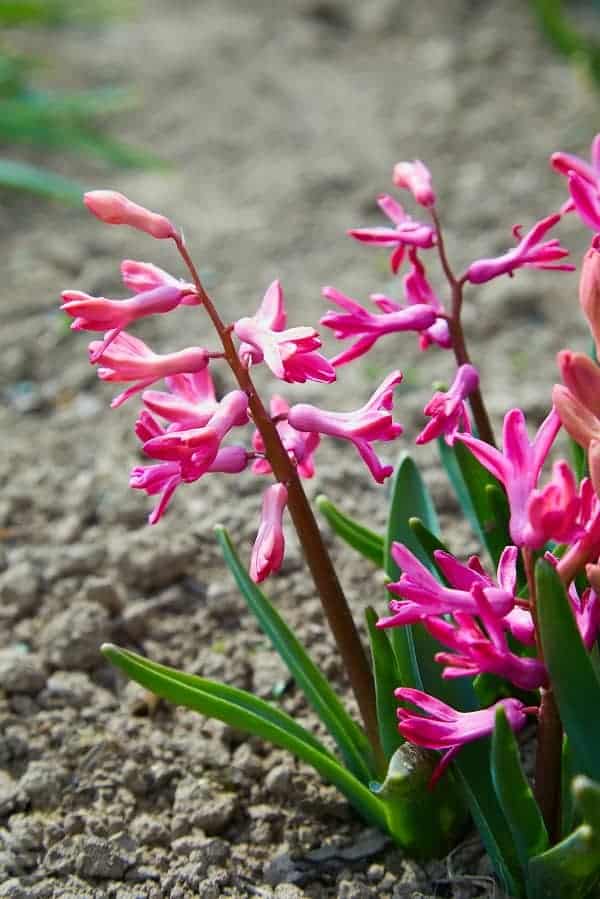
Frost injury
Sometimes, you may see small brown spots on stems and the foliage of your flower. The reason is a late spring frost. Prevent this issue by spreading a 2 inches (5 cm) thick layer of mulch around bulbs in autumn.
Bulb mites
These creatures feed on bulbs’ pulp and cause them to become hard and brown. Control the infection by destroying affected bulbs. Try to save the other ones by soaking them in hot water of 110 to 115 F (43 – 46 C) at least three hours.
Nematodes
These microscopic roundworms feed on the cells of Hyacinths. Over time, your flower will become sickly, stunted, and wilted, leaves bronze, with entirely damaged bulbs. Destroy these bulbs and add leaf mold to the ground to encourage beneficial fungi to kill nematodes.
Mosaic virus
You will know that you have a problem with virus infection once you notice the streaked color of flower petals. There is no cure, and you need to destroy all plants and sterilize gardening tools.
Rodents
Expect mice and voles to eat bulbs in winter. Prevent that problem by covering planting holes with hardware cloth. To stop squirrels and chipmunks from digging bulbs, you may lay a wire mesh of 1 inch (2.5 cm) over the beds.
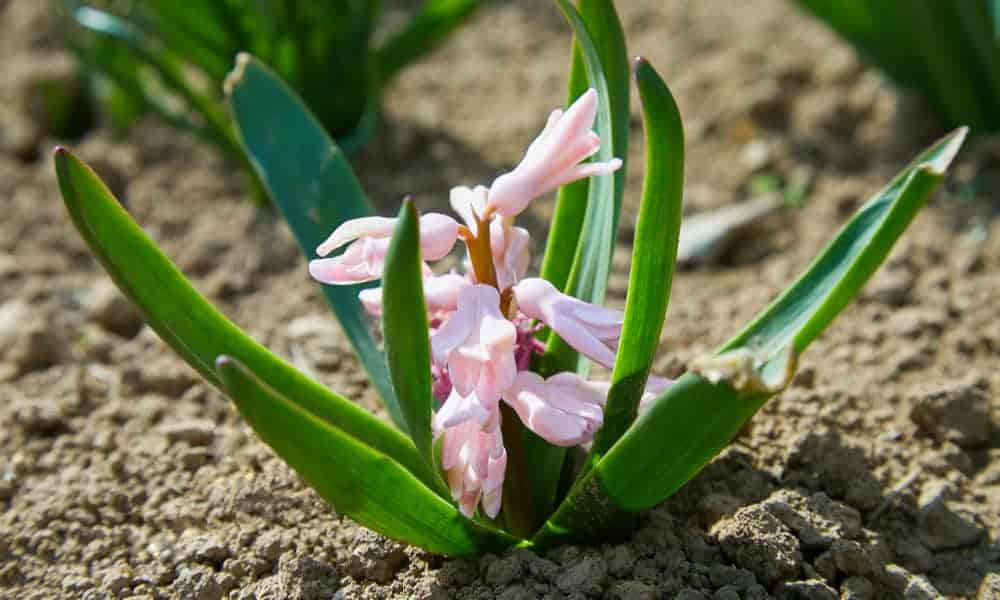
Leave a comment